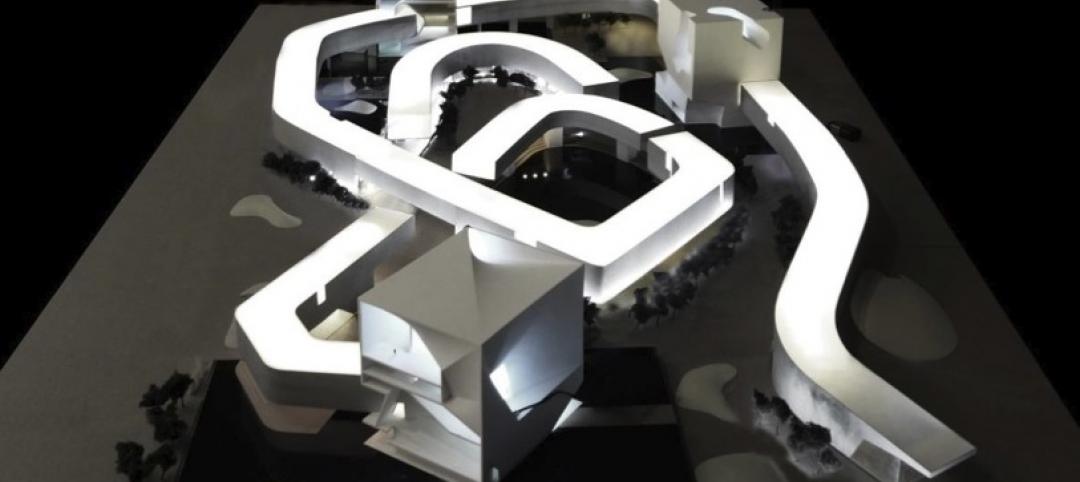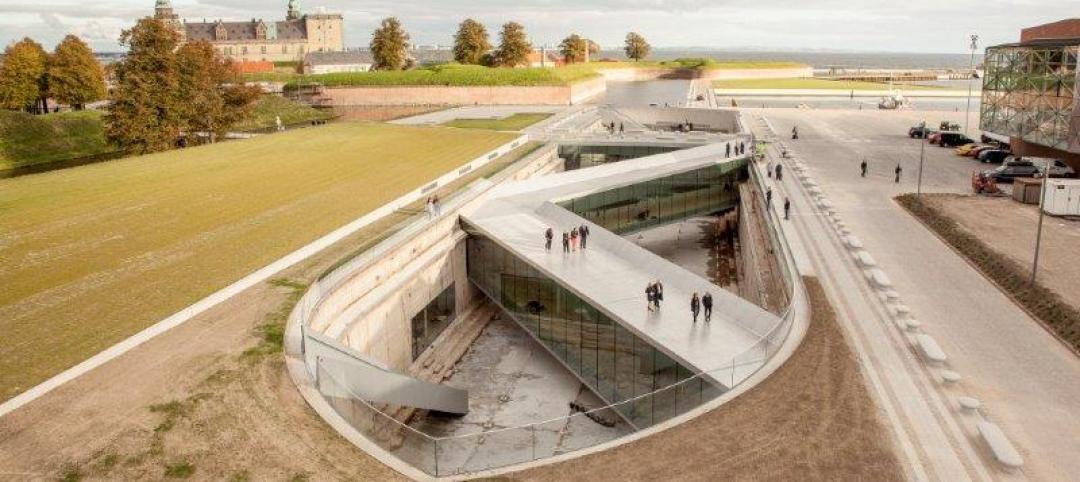
Designed by H. H. Richardson in the 1870s to serve the city's burgeoning Back Bay neighborhood, Trinity Church in the City of Boston would come to represent the essence of the Richardsonian Romanesque style, with its clay tile roof, abundant use of polychromy, rough-faced stone, heavy arches, and massive size. Its 9,500 tons rested on four elephantine granite pyramids, which were set atop 4,000 wooden pilings to prevent the structure from sinking into Back Bay's marshy wetlands.
 |
| PHOTOS: SHAWMUT DESIGN AND CONSTRUCTION |
Some 125 years after its completion, Trinity Church had grown into one of the largest Episcopal congregations in the country, holding 19 services a week and averaging 1,200 worshippers on Sundays. Trinity also drew 100,000 tourists a year, thanks to its status as a National Historic Landmark and one of the AIA's “10 Most Important Buildings in the United States.” Add to that more than 140 community programs that kept meeting rooms bustling 15 hours a day, six days a week, and it was easy to see how Trinity needed room for expansion.
Unfortunately, the passage of time had taken its toll on the building. The church's precious murals, stained glass, and intricate stonework had all been marred by a century-plus of wear. Worse, below ground, fluctuating water tables had damaged the wood pilings, threatening Trinity's very stability.
 |
| PHOTOS: SHAWMUT DESIGN AND CONSTRUCTION |
In 1995, church leaders inaugurated three years of master planning that led to a full-scale restoration and expansion of the church. The plan, like the structure itself, rested on four pillars: 1) return Trinity to its original beauty; 2) expand the church for future generations, 3) update the heating and cooling systems, and 4) keep the church operating during reconstruction.
Heavenly artwork
John La Farge, the father of the American Mural Movement, decorated the interior of Trinity Church with the goal of making parishioners feel as though they were “walking into a painting.” Bringing the church back to its original grandeur required years of historical research, planning, and troubleshooting.
To keep the renovation effort from interrupting religious services and tour groups, general contractor Shawmut Design and Construction and architects/preservationists Goody Clancy installed a series of mobile access towers high above the main sanctuary. Instead of having the usual ungainly wooden beams planted throughout the church, the scaffolding was supported by steel poles planted into the building's stone foundation pyramids.
 |
| Trinity Church occupies a tight, urban site in the heart of Boston’s bustling Copley Square. The Building Team focused on minimizing the impact construction would have on the neighborhood’s offices, hotels, and shops. PHOTO: FARRELL ASSOCIATES CONSTRUCTION PHOTOGRAPHY |
Work focused first on restoring basic structural integrity: repointing masonry, re-roofing, and installing flashing. The team went to great lengths to replicate and restore the original red mortar and replace broken stonework, much of which came from quarries that had vanished long ago. Fortunately, a cache of original stone remnants discovered under the church's west porch allowed the team to complete the repairs in fine fashion.
Moving on to Trinity's artwork, the conservators—including experts from John Canning Painting & Conservation Studios and Gianfranco Pocobene Studio—engaged in a nearly yearlong process that included restoring La Farge's murals and surrounding decoration, bringing back the original brick red background specified by Richardson and La Farge.
Growing God's house
Trinity's biggest concern, however, was lack of space for the growing congregation. Although church leaders had considered expanding into nearby buildings, Trinity's location in a tightly packed urban center limited that option. Instead of looking horizontally, Shawmut, Goody Clancy, and structural engineer LeMessurier Consultants turned their gaze downward to the basement.
Little more than a large crawlspace at the start of renovation, the basement eventually became a 13,000-sf addition, known as the Undercroft. Creating this space required lowering the basement by four feet, which sometimes had to be done by hand to avoid disturbing the sanctuary above or damaging wooden pilings below. Damaged pilings were repaired and capped with metal sections. Engineers also installed pumps to keep the pilings below the water line.
 |
| The Parish House, used for classes, meetings, and rehearsals, sits adjacent to Trinity Church and also was completely renovated and restored. PHOTO: DAVID LAMB ARCHITECTURAL PHOTOGRAPHY |
The excavation left a vast space that exposed the handsome raw granite of Trinity's pyramid footings. The stone was complemented by warm cherry millwork and, inspired by the church's collection of stained glass, a commissioned series of pivoting glass doors that allowed the Undercroft to be portioned up into rooms of various sizes.
Saving more than souls
Technically speaking, the Building Team's most difficult task proved to be updating the HVAC system. Due to its location, the building had no real “back end,” and M/E engineer Cosentini Associates determined that installing an HVAC system in the attic would pose a risk (moisture and vibration) to the works of art below.
The team turned to geothermal energy for a solution. Installing the geothermal pumps meant drilling six wells through soil and bedrock to a depth of 1,500 feet—twice the height of the nearby John Hancock Tower. The job was made doubly difficult by the need to drill without disturbing church services or social activity in adjacent Copley Square. Shawmut solved this problem by erecting noise-reducing wooden structures around the drill system.
All told, the Trinity renovation proved to be one of Boston's most remarkable transformations, earning numerous awards and acclaim from across the nation. Today, with its lusciously restored decoration, its gentle embrace of environmental values, and its firm commitment to future growth, Trinity carries on its founders' vibrant religious and community mission.
Related Stories
| Nov 13, 2013
Installed capacity of geothermal heat pumps to grow by 150% by 2020, says study
The worldwide installed capacity of GHP systems will reach 127.4 gigawatts-thermal over the next seven years, growth of nearly 150%, according to a recent report from Navigant Research.
| Nov 13, 2013
First look: Renzo Piano's addition to Louis Kahn's Kimbell Art Museum [slideshow]
The $135 million, 101,130-sf colonnaded pavilion by the famed architect opens later this month.
| Oct 30, 2013
15 stellar historic preservation, adaptive reuse, and renovation projects
The winners of the 2013 Reconstruction Awards showcase the best work of distinguished Building Teams, encompassing historic preservation, adaptive reuse, and renovations and additions.
| Oct 30, 2013
Steven Holl selected for Culture and Art Center in Qingdao, besting Zaha Hadid, OMA
Steven Holl Architects has been selected by near unanimous jury decision as the winner of the new Culture and Art Center of Qingdao City competition, besting OMA and Zaha Hadid Architects. The 2 million-sf project for four museums is the heart of the new extension of Qingdao, China, planned for a population of 700,000.
| Oct 30, 2013
11 hot BIM/VDC topics for 2013
If you like to geek out on building information modeling and virtual design and construction, you should enjoy this overview of the top BIM/VDC topics.
| Oct 29, 2013
BIG opens subterranean Danish National Maritime Museum [slideshow]
BIG (Bjarke Ingels Group) has completed the Danish National Maritime Museum in Helsingør. By marrying the crucial historic elements with an innovative concept of galleries and way-finding, BIG’s renovation scheme reflects Denmark's historical and contemporary role as one of the world's leading maritime nations.
| Oct 28, 2013
Urban growth doesn’t have to destroy nature—it can work with it
Our collective desire to live in cities has never been stronger. According to the World Health Organization, 60% of the world’s population will live in a city by 2030. As urban populations swell, what people demand from their cities is evolving.
| Oct 23, 2013
Gehry, Foster join Battersea Power Station redevelopment
Norman Foster and Frank Gehry have been selected to design a retail section within the £8 billion redevelopment of Battersea Power Station in London.
| Oct 18, 2013
Meet the winners of BD+C's $5,000 Vision U40 Competition
Fifteen teams competed last week in the first annual Vision U40 Competition at BD+C's Under 40 Leadership Summit in San Francisco. Here are the five winning teams, including the $3,000 grand prize honorees.
| Oct 18, 2013
Researchers discover tension-fusing properties of metal
When a group of MIT researchers recently discovered that stress can cause metal alloy to fuse rather than break apart, they assumed it must be a mistake. It wasn't. The surprising finding could lead to self-healing materials that repair early damage before it has a chance to spread.
















